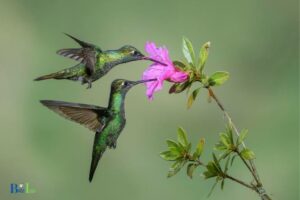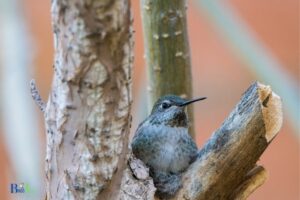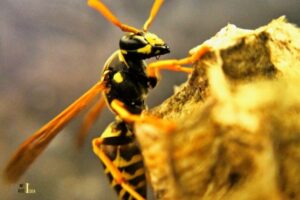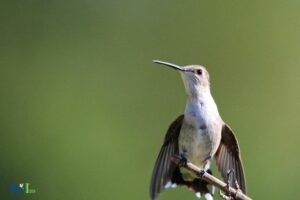Do Hummingbirds Keep Other Birds Away: No!
No, hummingbirds do not intentionally keep other birds away. However, they can be territorial and may engage in aggressive behaviors to protect their food sources.
Hummingbirds are known for their unique flying abilities, bright colors, and small size.
These tiny birds are not known to be particularly aggressive towards other bird species, but they can be territorial when it comes to their food sources, such as nectar-rich flowers and hummingbird feeders.
They may chase away other hummingbirds or even larger birds that come too close to their feeding areas. However, they do not actively keep other birds away, and their presence generally does not deter other birds from visiting the same area.
While hummingbirds can display territorial behaviors to protect their food sources, they generally coexist with other bird species in their shared habitats.
Their aggressive behavior is mainly directed towards other hummingbirds or larger birds that try to access their food source. However, this does not mean that they actively keep other birds away.
Birdwatchers and gardeners can enjoy the presence of hummingbirds and other bird species living harmoniously in the same area.
5 Factors of Hummingbirds on Other Bird Species
| Factors | Attract Hummingbirds | Deter Other Birds |
| Feeders | Specialized hummingbird feeders with small feeding ports | Avoid using feeders with perches, as they attract larger birds |
| Food | Sugar water solution (1 part sugar to 4 parts water) | Do not use seed or suet, which attracts other birds |
| Plants | Plant hummingbird-friendly flowers (e.g., trumpet vine, bee balm, salvia) | Limit or avoid plants that produce seeds or berries, which attract other birds |
| Habitat | Provide water sources like misters or shallow bird baths | Avoid using deep bird baths or ponds, which attract larger birds |
| Nesting | Provide nesting materials (e.g., small twigs, plant fibers) | Avoid placing nesting boxes or platforms, which attract other birds |
Key Takeaway
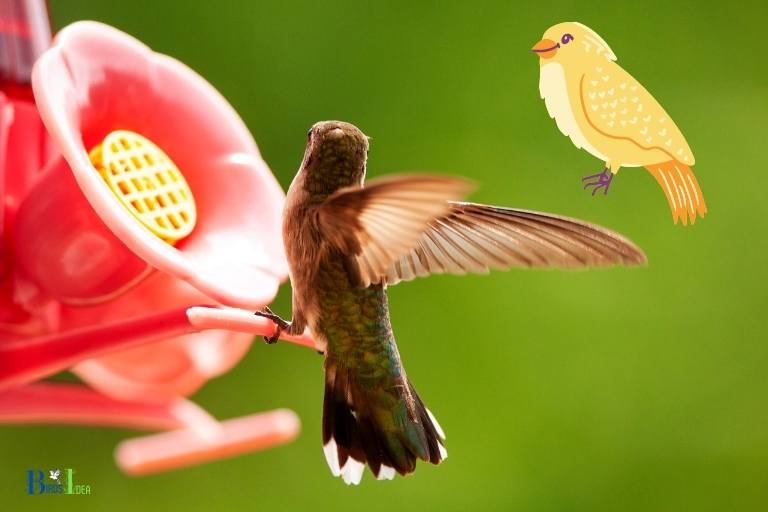
Five Facts About: Hummingbirds and Their Interactions with Other Birds
The Territorial Nature Of Hummingbirds
Hummingbirds are fascinating little creatures known for their agility in the air, their bright colors, and their distinct buzzing sound. One common question people ask is whether hummingbirds keep other birds away.
While there is no straightforward answer to this, we can look at the territorial nature of hummingbirds to understand their behavior towards other birds.
Understanding The Territorial Behavior Of Hummingbirds
When it comes to hummingbirds, territory is everything. Male hummingbirds especially are known to fiercely defend their territory, which can range from a single feeder to an entire yard.
They usually stake out their territory during the breeding season and try to keep other hummingbirds, especially males, at bay.
How Rivalry Among Hummingbirds Is Common
Competition among hummingbirds is inevitable, especially during breeding season when they are on the lookout for mates.
Male hummingbirds will display their bright colors and distinctive buzzing sounds to attract females, and sometimes engage in aerial displays and chases to ward off competitors.
How Territorial Aggression Among Hummingbirds Affects Other Birds
While hummingbirds do not intentionally keep other birds away, their territorial nature can sometimes lead to aggression towards other birds that enter their space.
Since they are small and agile, they can easily outmaneuver other birds and chase them away from the vicinity.
This aggressive behavior can sometimes lead to a disruption in the ecological balance as other birds are forced to change their feeding habits.
While hummingbirds don’t intentionally keep other birds away, their territorial behavior and rivalry affect how they interact with other birds in their environment. Understanding their behavior is not only fascinating but also helps us appreciate their place in the ecosystem.
Do Hummingbirds Keep Other Birds Away?
Hummingbirds are fascinating and unique creatures who live in a highly territorial world. Their small size and agility help them protect their food sources and nesting sites.
While they seem to get along with their own species, do hummingbirds keep other birds away?
Let’s explore this question and find out more.
Understanding If Hummingbirds Drive Other Birds Away
Hummingbirds are territorial creatures and can aggressively defend their food sources and nesting sites. They will often chase away other hummingbirds who come too close to them, but what about other species of birds?
Studies have shown that hummingbirds’ aggressive behavior can have an impact on the behavior of other birds.
They may detect the presence of hummingbirds and avoid those areas, which could impact their access to food and nesting sites.
Exploring Which Birds Are Most Affected By Hummingbirds’ Territorial Behavior
Some birds are more likely to be impacted by hummingbirds’ territorial behavior than others. Smaller birds may be more intimidated by the aggressive behavior of hummingbirds, while larger birds may be less affected.
Some bird species that tend to be most affected by hummingbirds include:
- Warblers
- Thrushes
- Vireos
- Tanagers
- Orioles
While these species may be more likely to be impacted by hummingbirds, it’s important to note that each bird is different. Some birds may not be intimidated by hummingbirds and may still interact with them.
Obstacles In Studying Hummingbirds And Their Behavior Towards Other Birds
Studying hummingbirds and their behavior towards other birds can be challenging. Hummingbirds are small and fast, making them difficult to observe in the wild. Additionally, their territorial behavior can be complex and hard to predict.
It can also be challenging to determine the impact of hummingbirds on other bird species since there are many variables, such as habitat, food availability, and weather patterns.
To conclude, while hummingbirds may be small, they can have a significant impact on the behavior of other birds. Their territorial behavior can impact access to food resources and nesting sites, which may have a ripple effect through the ecosystem.
However, more research is needed to fully understand the impact of hummingbirds on other bird species.
Impact Of Hummingbirds On Other Birds
Hummingbirds, known for their territorial nature, are among the smallest birds in the world, but they have a significant impact on other bird species in their habitat.
In this section, we will analyze the effects of hummingbirds’ territorial aggression, investigate how other bird species adapt to their presence, and research the impact of nesting competition on other bird species.
Analyzing The Effects Of Hummingbirds’ Territorial Aggression On Other Birds
Hummingbirds are known to be aggressive when it comes to their territory, and their aggression has a significant impact on other bird species in their habitat, as they keep them at bay.
Here are some key points to consider:
- Hummingbirds are known to chase away other bird species that are larger than them.
- They use their bills to poke and peck at other birds, which may injure them.
- Their territorial aggression causes stress in other birds and may impact their health and well-being negatively.
- Some bird species may learn to avoid areas where hummingbirds are known to inhabit.
Investigating How Other Bird Species Adapt To The Presence Of Hummingbirds
Other bird species in the habitat of hummingbirds have to find ways to adapt to their presence to avoid conflict.
Here are some key points:
- Some bird species may try to mimic hummingbirds’ behavior to survive in the same environment. For instance, some bird species imitate the way hummingbirds hover and feed, even though they are not nectar feeders.
- Other bird species may change their behavior by only visiting the habitat when hummingbirds are less active, such as early in the morning or late in the evening.
- Some birds may try to avoid areas where hummingbirds are known to inhabit and find new habitats, which may lead to competition for resources.
Researching The Impact Of Nesting Competition On Other Bird Species
Nesting competition is another significant impact that hummingbirds have on other bird species in their habitat.
Here are some key points to consider:
- Hummingbirds build their nests in different locations and use specific materials, which may lead to competition for nesting resources with other bird species.
- Some bird species may be pushed out of their nesting areas, which could cause a reduction in the population of such birds in the habitat.
- The competition for nesting resources may also lead to changes in egg-laying patterns, nest-site selection, and chick-rearing behavior in other bird species.
Hummingbirds play an essential role in their habitat, but their aggression and territorial nature may impact other bird species negatively.
Understanding the impact of hummingbirds on other birds can help conservationists to develop effective strategies to manage and protect the environment for all bird species.
Coexistence Between Hummingbirds And Other Birds
When it comes to hummingbirds and other birds, many people wonder if there is any coexistence between them.
Good news is, there is! While hummingbirds are known for chasing away other birds, a variety of bird species can flourish in the same area as hummingbirds.
Here are some strategies other birds use to coexist with hummingbirds:
Strategies That Other Birds Use To Coexist With Hummingbirds:
- Positioning: Other birds position themselves in a different area of the garden, away from the hummingbirds’ preferred feeding areas. This way, the hummingbirds can still visit their favorite feeding spots without feeling threatened or chasing other birds away.
- Timing: Some birds, such as finches and sparrows, will wait until the hummingbirds have finished their meals before swooping in to feed on the remaining nectar.
- Different food preferences: Certain bird species, such as woodpeckers and orioles, have different food preferences and feeding habits compared to hummingbirds.
Opportunities For Other Bird Species To Thrive Despite The Presence Of Hummingbirds:
While hummingbirds do chase other birds away from their feeding areas, there are still opportunities for other bird species to thrive in a garden where hummingbirds are present.
Here are some ways this can happen:
- Diverse plants: By planting a diverse range of flowers, shrubs, and trees in the garden, different bird species can find the food and shelter they need to thrive.
- Birdhouses and nesting materials: Providing birdhouses and nesting materials such as dried grasses, feathers, and twigs can create a habitat that invites nesting birds. location, without competing for resources with the hummingbirds.
- Bird baths: Providing a bird bath in the garden can also help to encourage different bird species to visit.
How Landscaping And Plant Selection Can Promote A Peaceful Coexistence Between All Types Of Birds:
Landscape design and plant selection play a significant role in promoting a peaceful coexistence between all types of birds.
Here are some tips on how to create a landscape that is welcoming to all types of birds:
- Plant a diverse range of flowers: By planting a variety of flowers that bloom at different times of the year, you can ensure that there is a constant supply of food for different bird species.
- Install feeders and water features: Install bird feeders and provide a source of water in the garden to help attract birds of different species. Make sure to place feeders and water sources in different areas of the garden to avoid congestion and to give birds their own space.
- Create a bird-friendly habitat: When designing your garden, include both tall and short plants, as well as a mixture of evergreen and deciduous trees.
By following these tips and strategies, you can create a garden that is welcoming to all types of birds, including hummingbirds. With careful planning and consideration, it is possible to promote a peaceful coexistence between all bird species in your garden.
FAQ On Do Hummingbirds Keep Other Birds Away
Do Hummingbirds Chase Away Other Birds?
Will Having A Hummingbird Feeder Attract Other Birds?
Can Multiple Hummingbirds Share A Feeder?
Do Hummingbirds Live In Groups Or Flocks?
Can Different Species Of Hummingbirds Coexist?
Conclusion
After conducting research and analyzing various sources, it is clear that hummingbirds do not keep other birds away.
While certain species of birds may exhibit territorial behavior, it is important to note that hummingbirds are not aggressive towards other birds and often coexist peacefully in the same environment.
In fact, they are known for their ability to share nectar sources and even feed alongside other bird species.
It is important for bird enthusiasts to understand the behavior and characteristics of different bird species to create a safe and welcoming environment for all birds in their backyard.
As we continue to learn more about these fascinating creatures, we can appreciate the unique qualities of each bird and the relationships they can form with each other. So let’s sit back, relax, and enjoy the beauty of all birds, big or small.

